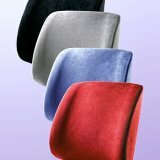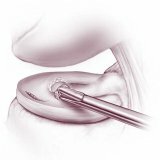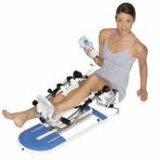Adhesive capsulitis: symptomatology, diagnosis and treatment of the disease
 Pain in the shoulder can appear in every person. It appears suddenly and can catch us at the most inopportune moment. There are many reasons why pain appears in the shoulder. Pain can be of different nature: fettering, acute, shooting. Very often such pains provoke an adhesive capsulitis.
Pain in the shoulder can appear in every person. It appears suddenly and can catch us at the most inopportune moment. There are many reasons why pain appears in the shoulder. Pain can be of different nature: fettering, acute, shooting. Very often such pains provoke an adhesive capsulitis.
A bit of physiology and anatomy
Before starting treatment, it is necessary to understand physiology. In a healthy person, the joints are well-mobile and allow any movement in different directions. The shoulder joint has a rounded shape and a small concave articular cavity near the scapula. The head of the humerus is firmly fixed in this cavity with muscles and ligaments. The joint capsule is the connective tissue that surrounds the joint and ensures its operability. The inner surface of the capsule is covered with the synovial membrane, which is filled with nerves and vessels. The state of this shell depends on the operability and mobility of the joint.
Outside, the joint capsule is attached by elastic ligaments. And the muscles and a large capsule allow the joint to move in different directions. From this it follows that the volume of movements directly depends on the state of the tendons and muscles. If any damage occurs, an inflammatory process may develop that will trigger the appearance of severe pain in the shoulder.
What is an adhesive capsulitis?
Adhesive capsulitis begins to develop when the joint capsules and the synovial membrane that lining it become inflamed. As a result of the inflammatory process, the tissues of the capsule change - they wrinkle and thicken. If you do not get treatment in time, then tissue scarring occurs. The capsule decreases in size, and the elasticity is impaired. However, unlike arthrosis or arthritis, with an adhesive capsule the structure of the cartilage and joint does not change.
Numerous studies have shown that a woman suffers from this ailment much more often than men. Most often, a person suffers from only one joint, but there are cases when both healthy joints suffer. Still this disease is called a humeroscapular periarthritis.
Why does a capsulitis occur?
To date, doctors have not figured out the true cause of this disease. But still they have some assumptions about this. Some doctors believe that an adhesive capsulitis occurs due to shoulder injuries. The injury can lead to a fall, a blow to the shoulder joint, an accident, a sharp shoulder movement, surgery and so on. Also, problems in the cervical spine can lead to the development of the disease. For example, protrusion, osteochondrosis, hernia of intervertebral discs, displacement of vertebrae and so on. Often, capsulitis occurs in people who are engaged in tennis, badminton, sports, monotonous work.
With the above factors, capsulitis may occur immediately or after a time. Very often a person can not even remember the trauma that caused the development of the capsule. Doctors noticed that people with professions such as seamstresses, warriors, weavers, musicians, hairdressers, sportsmen, painters and dentists are most often complaining about capsulitis.
Sometimes, some diseases provoke the development of a capsulitis: cancer, autoimmune diseases, thyroid disease, diabetes, gall bladder disease, post-stroke complications, menopause, myocardial infarction.
Symptoms of the disease
Capsule has its own characteristic symptoms, by which it can be determined. First, a sick person has dull and aching pain when he performs any movements. The pain appears during the performance of the usual homework. If you do not take time to medicate and let things go on your own, the pains begin to bother during washing, combing, brushing your teeth, lifting the bag, cleaning the apartment. Over time, the pain spreads from the shoulder area to the neck, upper back and arm. At night, it intensifies and becomes sharp and unbearable. Often it is because of pain that a person can not fall asleep. All these signs are characteristic for the first stage of the disease.
In the second stage, the symptoms intensify. It becomes difficult for a man to move his shoulder and arm, the shoulder joint becomes stiff. During this period there is a process of scarring of the capsule of the joint. During the examination, the doctor may notice that the injured shoulder is much denser than the healthy one. Because of the lack of mobility, the shoulder is called "frozen".If you do not perform any movements by hand, the pain passes. But the slightest pat on the shoulder can provoke severe pain.
In the third stage, the mobility gradually returns. However, not in all patients the volume of movements is completely restored. To restore the mobility of the shoulder can take months.
How is the disease diagnosed?
If the first symptoms appear, you need to see a doctor immediately so that he can diagnose the disease at the time. The doctor examines the patient, carefully probes the shoulder and asks for different movements with his hand. Functional tests are then carried out. To confirm the diagnosis, ultrasound, arthrography, a blood test and radiography are prescribed.
How is capsulitis treated?
As mentioned above, when you have the first symptoms of the disease you need to contact one of these specialists: neuropathologist, traumatologist, orthopedist, arthrologist or surgeon. The earlier treatment is prescribed, the greater the chance of a complete recovery of shoulder mobility. At the first stages of treatment, it is necessary to completely exclude any burden on the affected shoulder.
To begin with, doctors prescribe drug therapy, the purpose of which is to relieve the pain. After this treatment is aimed at restoring the mobility of the shoulder. Complex physiotherapy and medication are used. Anti-inflammatory drugs are prescribed: cream, tablets, gels, ointments. Often appointed Ibuprofen, Diclouran Gel, Naise, Ketanov, Brufen, Dolgit and others.
If after the use of tablets and ointments of relief does not occur, then injections with corticosteroids are prescribed. Typically, this treatment takes about 4 procedures. Very useful electrophoresis, magnetotherapy, mud therapy, acupuncture, paraffinotherapy, laser therapy, acupuncture.
In severe cases, surgical intervention is prescribed. An arthroscopic operation is performed, during which the inflamed scar tissue is removed. As soon as the exacerbation goes away, the patient is given special exercises, which are aimed at complete restoration of mobility.
Some doctors advise that during the main treatment of medicines use and folk remedies for treatment. To do this, inward tinctures, broths are taken. Externally used ointments, oils and tinctures for rubbing. Here are a few recipes:
- Mix 1 tbsp. Marsh wool with 2 tbsp. Field horsetail and pour 300 ml of water. Brew this mixture, let it brew for 40 minutes, then strain and take small amounts throughout the day.
- Brew tea from St. John's wort with a glass of boiling water, insist it for half an hour. Take infusion four times a day for 50 ml.
- The painful shoulder is useful to rub with tincture from a golden mustache and a saber.
- Well this ointment helps. Mix honey, soda, salt and mustard powder in equal proportions. Apply this mixture on a sore shoulder, wrap it with something warm and hold this compress for at least three hours.
- You can prepare a tincture for grinding. For this tincture you need to take dried flowers of white lilac - 3 tablespoons, 2 pods of red hot pepper, crushed burdock root - 1 tbsp. L., Vodka - 1 liter. All the ingredients need to be poured with vodka and put the mixture in a dark place for three days. Then the infusion should be filtered and used for grinding.



